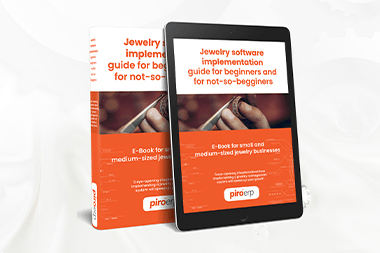What motivates you every day when you are running your jewelry business? I assume it's the desire to improve it, achieve greater success, and ensure steady business growth.
However, the challenge lies in maintaining consistency in your daily work while striving to accomplish your mission. What should be changed in your company today to expedite goal achievement? The answer is not to work harder but to work smarter.

It is easier said than done. Below, we've outlined several tips that can substantially impact your jewelry business if consistently applied.
1. Frequent ad-hoc decisions are dragging your company back
 The most significant mistake you can make is to operate your business by making ad-hoc decisions frequently. While ad-hoc decisions are needed when you are dealing with unexpected challenges, too many situations like this could indicate bigger organizational problems like lack of information and transparency or lack of clear vision among your employees.
The most significant mistake you can make is to operate your business by making ad-hoc decisions frequently. While ad-hoc decisions are needed when you are dealing with unexpected challenges, too many situations like this could indicate bigger organizational problems like lack of information and transparency or lack of clear vision among your employees.
Ad-hoc decisions shouldn’t be normal at your company. Typically, you see the signs of it when you label various things as important each day, but ultimately, nothing truly progresses in the right direction.
How could jewelry management software help In this matter? First of all, it provides more transparency and real-time data, and with the built-in quality assurance points, you can filter the situations before they become an issue. With such software, you will get the chance to stop managing problems reactively.
2. Difficulties in measuring your employees’ accountability?
 If the personnel in your jewelry business carry out tasks based on their own judgment, yet fail to take ownership of their errors and their productivity, the issue isn't with them. It's with you, as a leader, for not equipping them with a clear job framework and a system.
If the personnel in your jewelry business carry out tasks based on their own judgment, yet fail to take ownership of their errors and their productivity, the issue isn't with them. It's with you, as a leader, for not equipping them with a clear job framework and a system.
Without going into further details, the job framework clarifies your expectations, performance indicators and methods of how they need to work, while the jewelry management system measures it. It clarifies the processes they must follow and collects the information you need for accountability. How many times did they make or commit the same mistake repeatedly? Why do you deliver orders to your clients with delays frequently? Transitioning from reactive to proactive management will solve many of your similar problems.
Do you follow from where I’m coming from? The absence of an appropriate system to evaluate employee accountability could mean that errors will persist and disorders remain unaddressed.
3. A management system brings more order to your company, but will it be welcomed?
 One of the key advantages of having a jewelry management system in place is that it allows you to identify and address issues before they arise, reducing the need for reactive solutions. Another result and benefit is the enhanced ability to measure employee accountability.
One of the key advantages of having a jewelry management system in place is that it allows you to identify and address issues before they arise, reducing the need for reactive solutions. Another result and benefit is the enhanced ability to measure employee accountability.
Will your employees appreciate the introduction of a jewelry management system like this if they were allowed to act without specific boundaries before?
I have my doubts. However, your objective should be to raise awareness: implementing such a system isn't a reflection on them; it's intended to enhance the business's processes so you can level up from the reactive mode.
Because of more control, some employees might choose to leave, while others will embrace the opportunity to work with greater responsibility. Ultimately, the priority should be on establishing order, not catering to the egos of specific employees.
4. Lead by example in behavior; otherwise, you can diminish the benefits of the jewelry management system.
If your company currently relies on Excel sheets, a significant portion of information, particularly process-related details, remains concealed. Upon implementing an integrated system, transparency and control are heightened. This shift allows you to move away from firefighting and focus on effective business management.
Furthermore, staff motivation can experience a noteworthy boost as feedback regarding accountability becomes more prompt. People tend to thrive in organized environments.
But keep in mind that:
if a leader is prone to making ad-hoc decisions and frequently shifting priorities, employees will likely mimic this behavior.
Therefore, implementing a jewelry management system won't automatically rectify this issue; instead, it could lead to confusion and frustration among the staff. Even if the system provides clear instructions for specific processes, employees may continue to deviate from them due to the prevailing organizational culture that encourages such conduct.
In such a scenario, it's easy to place blame on the system for not functioning perfectly...
5. Assessing the value of eliminating firefighting and navigating growth
 The decision to integrate jewelry software should not be impulsive. While the enticing benefits are alluring, you must be prepared to invest both time and money. Remember to create a change management plan - as discussed in our previous blog post.
The decision to integrate jewelry software should not be impulsive. While the enticing benefits are alluring, you must be prepared to invest both time and money. Remember to create a change management plan - as discussed in our previous blog post.
Such endeavors often stretch companies to their limits, demanding significant investments and hard work. However, keep in mind that if you channel the time spent on firefighting into successfully launching a jewelry system, the effort will yield long-term rewards.
Ideally, a company leader will come to understand the profound impact of ERP implementation, realizing that it will shape the organization's structure for the next 8-10 years, thereby defining its future framework. Until this realization takes hold, the system implementation might seem like a promising idea that has fallen short of expectations.
6. Secure team support for the project; a one-person army can never win battles.
 In most instances, leaders aren't directly involved in software implementation. They make the decision to adopt the software and then delegate the implementation to a manager, department leader or outside consultant. This raises several questions:
In most instances, leaders aren't directly involved in software implementation. They make the decision to adopt the software and then delegate the implementation to a manager, department leader or outside consultant. This raises several questions:
- Are employees as motivated as the leader when it comes to embracing a new system?
- Whose responsibility is it to communicate the software's benefits to other employees?
- Is the project manager receiving full internal support, or are they left to handle the project as a one-person team?
- Are the expectations realistic? How do you respond if configurations don't align with your desires? Are you open to adapting processes if necessary?
Hence, initiating change isn't sufficient, nor is entrusting a single individual with such a transformative project. For success, nearly the entire organization must be onboard and invested in the endeavor.
Are you prepared to devote sufficient attention to this entire process?
Final reflections: Why do jewelry companies often postpone change and resort to firefighting for extended periods?
Over time, we've encountered numerous jewelry companies that initially expressed interest in a software solution, engaged with us, and then suddenly lost momentum. Frequently, they put the project on hold for a year or two before circling back to request a new demonstration.
What’s behind all this?
While we comprehend their reasoning - the perceived high cost, the notion that their business isn't large enough for a system, organizational unreadiness for change, or a lack of suitable personnel to lead the project - there's one crucial aspect every leader should recognize:
Leading the organization reactively is often a consequence of underlying organizational issues that hinder business growth.
Random issues and ad-hoc decisions won't be eliminated unless the organization invests in a robust management system. Sooner or later, this must take place.
What might perplex leaders is that the outcomes aren't always immediate. Often, the pieces fall into place after a year or two of implementation. At that point, leaders can assess whether the desired organizational changes (in terms of systems, order, and personnel) have yielded the anticipated results.
If you are ready to invest in a robust management system, PIRO Fusion, our cloud-based jewelry software, is here.
FAQ: How PIRO Fusion helps jewelry businesses shift from reactive to proactive management
- How does PIRO Fusion reduce reliance on ad-hoc decision-making?
PIRO Fusion provides transparency and real‑time data with built‑in quality checkpoints - so jewelry businesses can identify small issues before they escalate, shifting from reactive firefighting to proactive oversight. - How does PIRO Fusion enhance employee accountability in jewelry operations?
With defined job frameworks and KPIs embedded in its workflows, PIRO Fusion clarifies roles and tracks performance - helping staff own their responsibilities and drastically reducing recurring mistakes. - Will implementing PIRO Fusion bring order or fear among employees?
Implementing a structured system like PIRO Fusion helps detect problems early and improves consistency - but requires clear communication to show it’s about process enhancement, not blame. Proper change management is key. - Why must leaders role-model proactive behavior for PIRO Fusion to succeed?
When leadership resorts to shifting priorities or reactive decisions, employees model that behavior - even if the system provides clarity and structure. Leaders must demonstrate consistency to reinforce system benefits. - How can PIRO Fusion help jewelry businesses escape perpetual firefighting and support long-term growth?
Rather than quick fixes, PIRO Fusion requires an investment in change management - but once the system is embedded, it reshapes organizational structure, enabling stability and sustainable growth over 8–10 years.







